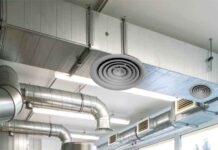
A recent survey conducted by Honeywell found that 77% of surveyed U.S. facility managers in the education sector say COVID-19 has caused them to permanently rethink how their facility operates, and 34% said that they are planning to invest in IAQ solutions in the next
12 to 18 months.
Detailing on their findings, Manish Sharma, Vice President and Chief Technology and Product Officer of Honeywell Building Technologies, said, “The demand for better indoor air quality isn’t just about responding to COVID-19. As science increasingly points to the correlation between healthier indoor air and well-being, we expect to see improved air quality on the ‘must have’ list of parents and educators. By taking advantage of federal funding and following expert guidelines, schools have an opportunity to invest in better air and ultimately in the improved performance and well-being of students, teachers and their communities.”
Honeywell Healthy Building engineers recommend that school administrators take immediate action to assess and address the state of school environments, including the following steps:
Install sensors to actively monitor factors that impact IAQ
IAQ can be impacted by a number of different factors, including: particulate matter, Volatile Organic Compounds (VOCs), CO2, temperature and humidity. IAQ sensors monitor these factors and help inform necessary adjustments to meet recommended parameters. Ideal indoor relative humidity should range from 40 to 60% to help reduce the spread of airborne pathogens. Simultaneously, indoor air temperature should range between 68.5 to 80.5 degrees F, depending on the season (cooler in the winter, warmer in the summer).
Pointing at the traditional approach, Sharma said, “We’re seeing people focus on just one factor – CO2 – as the proxy measurement for indoor air quality. While CO2 is important, school facility managers should be actively monitoring a range of parameters, such as particulate matter, VOCs, temperature, humidity, and air pressure, to name a few, and take appropriate automated actions related to filtration, ventilation and pressurization to create healthier indoor air.”
Place portable HEPA air purifiers in high traffic areas to reduce distribution of airborne contaminants and pull contaminated air away from occupants
Mobile air purifiers with HEPA filters and activated carbon filters are known to capture particles as small as 0.3 microns, offering an effective and cost-conscious option for schools. Moreover, plug-and-play solutions like portable air purifiers do not require infrastructural changes as they operate independently of HVAC systems. They can be particularly useful in buildings that don’t have forced-air heating or ventilation.
A recent study by Honeywell used computer modeling to simulate air flow and movement of particulates, such as dust, dirt, smoke and respiratory droplets, in common areas of hotels. In the study, 97% of small particles were captured by air purifiers, which made a significant impact on the improvement of air quality.
Maximize ventilation to bring in the maximum amount of outside air when rooms are occupied
Recent research from the Centers for Disease Control and Prevention found the incidence of COVID-19 was 39% lower in schools that improved ventilation by opening windows or doors or using fans or those tactics in combination with air filtration methods.
Building managers can adjust ventilation in schools and other buildings by extending the operating times of HVAC systems to run before the earliest staff arrive for the day and after the last occupants have left for the night, helping purge air from the building. Fresh air intake should be expanded through natural or mechanical ventilation to the maximum amount possible.
Highlighting a very common wrong notion, Sharma said, “We cannot mistake just opening windows as effective ventilation. Cracking a window has been the solution some schools have come up with to improve air flow in classrooms but it is not sufficient. Ventilation is imperative to improving indoor air quality, but so is effective air filtration, proper pressurization and meeting optimal temperature and humidity levels.”
If energy use is a concern, augment the spaces with filtration solutions like mobile HEPA Air Purifiers to reduce the dependence on ventilation for dilution.
Use analytics to monitor occupancy of rooms and common areas and dynamically adjust indoor air quality parameters
Schools often have fluctuating occupancy levels in classrooms and common areas. While occupancy can impact indoor air quality, making indoor air quality upgrades isn’t something that should wait until occupancy numbers are known. Video analytics and sensors can help schools to track and manage occupancy and adjust indoor air quality parameters dynamically based on how many actual people are in a space.
Advanced video analytics technology allows facility managers to manage compliance to social distancing and face covering guidelines, especially in common areas. The Honeywell Sine mobile solution helps in managing varying occupancy levels, can pre-screen students, staff and visitors with health questionnaires before arrival, and track the flow of people throughout the space when integrated with access management platforms.








